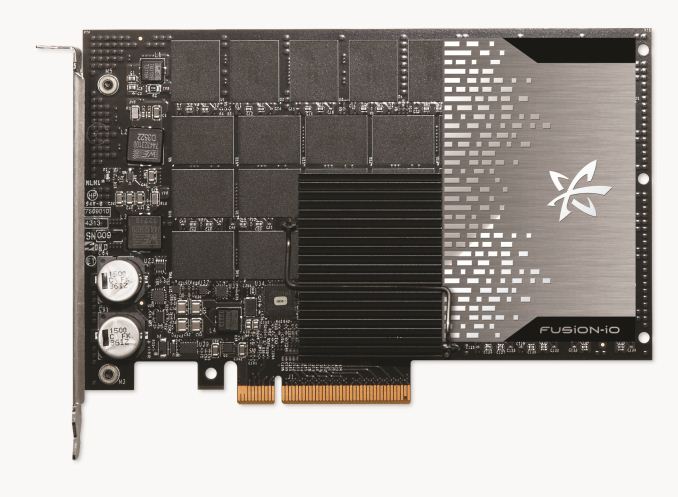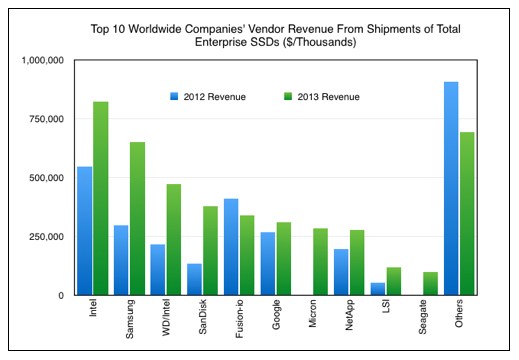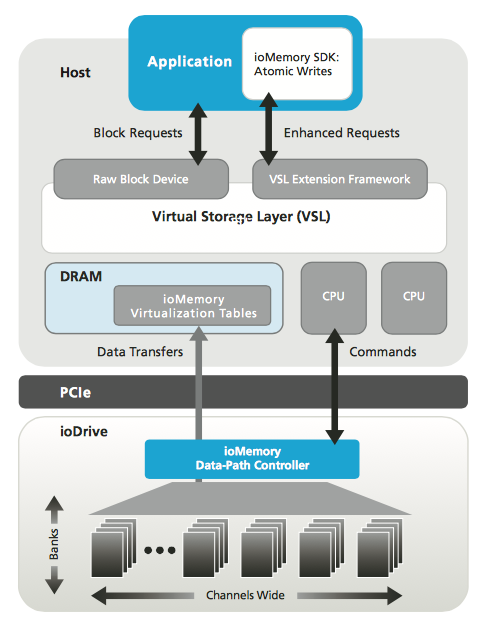The State of SanDisk
by Kristian Vättö on December 5, 2014 8:00 AM ESTThe Enterprise
In mid-July SanDisk announced their acquisition of Fusion-io and the acquisition was completed a couple of week prior to Flash Memory Summit. I posted my initial thoughts when the news hit the public, but I feel that it's worth doing a bit deeper analysis now that I have given it some more thought and discussed it with John Scaramuzzo, senior vice president and general manager of SanDisk's enterprise business.
SanDisk has managed to establish itself as one of the key players in the enterprise SSD space over the past few years. The acquisitions of Pliant in 2011 and SMART Storage Systems in 2013 provided SanDisk with strong expertise and product lineups for SATA and SAS SSDs but left the company without a solid long-term plan for PCIe. I heard Pliant's initial roadmap included plans for PCIe-based solutions as well, but it looks like those plans never materialized.
Up until the Fusion-io acquisition, the Lightning PCIe SSA was the only PCIe solution in SanDisk's enterprise product portfolio, and as a matter of fact that drive is internally a SAS-based design with a PCIe to SAS bridge onboard. In other words, SanDisk had practically zero real PCIe solutions for the enterprise, while at the same time SanDisk's biggest competitors, such as Intel and Samsung, have had PCIe drives for a long while already.
Fusion-io's 3.2TB Atomic Series SSD
Fusion-io's strategy and product portfolio, on the other hand, was a complete opposite. From the beginning Fusion-io has focused on PCIe storage, which dates all the way back to 2007 when the company released its first ioDrive that utilized a PCIe x4 interface and was capable of speeds up to 800MB/s. Not only was Fusion-io early in the market, but the company was also able to garner a few massive and very important clients – the most notable being Facebook and Apple. I don't think it's an overstatement to say that Fusion-io can be considered as the pioneer of PCIe storage because it was the first company to turn PCIe SSDs and storage in general into a large, successful business.
But stories eventually come to an end. The competitive advantages Fusion-io had were its PCIe technology and several high-level customers, but the advantages were lost when the NAND manufacturers stepped into the PCIe territory. It's nearly impossible for a company that has to source its NAND from a third party to compete against another company that manufactures NAND in-house since the latter will always have advantages in cost. While Fusion-io didn't lose its customers to competitors overnight, it's clear that especially Intel and Samsung snagged a share of Fusion-io's business in the past couple of years.
In a nutshell, the acquisition brings SanDisk the long-needed expertise in PCIe storage along with Fusion-io's broad PCIe product portfolio. The acquisition is now a bit over 100 days in and the Fusion-io employees have been integrated into SanDisk's existing teams. Initially Fusion-io's engineering team was separate and worked under Lance Smith, the former President and COO of Fusion-io, but Mr. Smith decided to leave SanDisk and pursue other options. Last week a data virtualization startup Primary Data announced that Mr. Smith has joined the company as the new CEO, which explains his quick departure from SanDisk.
All the engineering talent has now been unified and the team is lead by Mr. Scaramuzzo. With everyone under the same roof, the roadmaps are now in the process of being integrated to bring the expertise together. It will be a while before we see the fruits of the acquisition, but in the meantime the latest Fusion-io products will transition to SanDisk NAND for increased cost efficiency.
But what about NVMe? That has been the hot topic in the industry this year and I bet many of you are wondering what is SanDisk's and Fusion-io's play in that field. The short version of their strategy is that Fusion-io already has a technology called Virtual Storage Layers (VSL), which is essentially a driver/software stack similar to NVMe. The truth is that NVMe isn't really anything new from a technology perspective, but what makes it alluring for many manufacturers is the fact that the NVMe drivers are universal and already supported by the latest operating systems. Technologies like VSL are rather expensive to develop and require expertise because there is no framework available (i.e. everything has to be developed from scratch), but on the other hand an in-house driver like VSL allows for more customization and optimization.
However, that doesn't mean that SanDisk has no interest on NVMe whatsoever. The company sees that as the entry and mid-level enterprise SSDs move from SATA and SAS to PCIe, NVMe will be one of the key factors because of easy and quick deployment. For that market segment the NVMe spec and its limitations are fine – it's only the high-end segment where the benefits of VSL are more prominent. It's actually likely that many manufacturers will turn to custom NVMe drivers anyway for higher and more optimized performance, and in fact that is already happening with Intel providing its own NVMe driver for the P3600/P3700.
Lastly, let's quickly discuss the ULLtraDIMM. I wrote a quick piece on ULLtraDIMM right after Flash Memory Summit, but SanDisk has already scored Huawei as the third ULLtraDIMM partner (in addition to IBM and Supermicro). The first generation product that is currently available is internally based on a pair of SATA 6Gbps controllers, but SanDisk said that a native DDR to NAND controller is possible in the future if the market adopts the new form factor well. As usual, the industry is fairly slow in adopting new form factors, so it's hard to say whether NAND DIMMs will really take off, but it's a very interesting and potentially useful technology.
Final Words
All in all, SanDisk is definitely one of the most interesting NAND companies going forward. USB drives, eMMC solutions, SSDs and even the storage arrays from the Fusion-io acquisition are all built on NAND, which puts SanDisk in a unique position as it's the only NAND manufacturer that focuses solely on NAND products. The company can't turn to alternative revenue sources like e.g. Intel and Samsung can, but on the other hand that's also SanDisk's strength as all the know-how and experience in the company is related to NAND in one way or the other.
Ultimately next year will be crucial for SanDisk because it determines whether the company can materialize all the underlying potential from the Fusion-io acquisition and become a serious competitor to Intel and Samsung in the enterprise space. The pieces are definitely there, so it's just a matter of execution now.














132 Comments
View All Comments
bernstein - Friday, December 5, 2014 - link
since even my granma now uses a notebook with an ssd i can only speculate... we as a family only use harddisks in nas (note that excluding videos & backups an 1TB ssd could replace it easily) & as a second large storage drive where needed (2TB steam library being one example)however most people i know a) have no clue how much space they actually need & b) play it save (when buying a notebook now and they think they might use 256GB in five years they buy the 2TB because they might need it and it's often the cheaper notebook)
nandnandnand - Friday, December 5, 2014 - link
VNAND or diegaradante - Friday, December 5, 2014 - link
An easier/cheaper way to migrate the OS and software from an HDD to an SSD would be nice. Most SSDs don't include something like Acronis and buying it separately is cost prohibitive when using a smaller capacity SSD as it adds something like $30 to the effective cost.I think one thing that would be very nice to see though would be OEMs selling desktops and laptops with a SSD as the default drive rather than the HDD. Otherwise personally, when I buy a laptop with an included HDD but not an SSD and only 1 drive bay, taking the HDD out and replacing it with an SSD is a tough pill to swallow when it means the cost of the HDD as part of the laptop purchase price (probably something around $40-60) was wasted. Or encourage laptop manufacturers to include easily accessible bays for more than a single 2.5"/mSATA drive, and still have the default one an SSD so the OS doesn't have to be migrated afterwards.
Also, moving mobile devices (phones/tablets) away from the godawful slow eMMC controllers to proper SATA/comparable controllers and half decent NAND could help. If the snappiness of the average user experience on a well advertised mobile device increased significantly to where average people could notice the difference in an overwhelmingly positive manner, with proper marketing the everyday appreciation for SSDs could increase and therefore make average consumers more interested in making sure their nonmobile computing devices have fast storage. People seem to be willing to pay a lot more for a flagship smartphone while simultaneously skimping on a crappy laptop/desktop. And people seem to be spending more and more time interfacing with a smartphone than a desktop or laptop these days.
TemjinGold - Friday, December 5, 2014 - link
When Apple explained what "x GBs of ram" meant to the masses, they did it in terms the masses would understand (i.e. "It's this many songs or this many movies." If SSD makers want to get the masses onboard, they need to create a "metric" that the masses will understand. As the main benefit is speed, they should start labeling their SSDs as "x seconds to start the average program." This way, with HDDs also labeled as such, the masses have clear concrete metric that they understand.Doomtomb - Friday, December 5, 2014 - link
Isn't it obvious? The reason NAND capacities aren't increasing is because people (consumers) aren't demanding more. Why is that? Two words: CLOUD STORAGE.MrSpadge - Friday, December 5, 2014 - link
But what about the ones who're notusing SDDs yet? Bet they're not using cloud storage in any serious way either (I'm not talking about those 2 GB Dropboxes).WelshBloke - Friday, December 5, 2014 - link
Really? People aren't choosing the fastest storage medium over a more expensive, slower, more insecure medium?Seriously nothing against cloud storage but if grandma doesn't know the benefits of an SSD she aint gonna know how to use cloud storage.
Cerb - Sunday, December 7, 2014 - link
That doesn't make much sense. Cloud storage makes the HDDs they are buying less important. It's less 1TB SSDs v. 120GB SSDs as it is 250GB SSDs v. 2TB HDDs.XZerg - Friday, December 5, 2014 - link
Well those who are tech savvy know about SSD and its benefits, and have already picked it up. Those who are not tech savvy and buy their systems from OEMs (eg: dell, hp, lenovo, acer, ...) do not know about it. To make matters worse the OEMs are charging a massive premium to switch to SSD and are not designing most of their systems to be able to contain both SSD and standard HDD at the same time. So those non-tech savvy users end up going for the big numbers, i.e. TBs, and not the performance, even though they barely use 200GB in total.So to get a higher penetration or sales, get the OEMs on board to start designing their systems better, promoting and stop charging insane premiums on SSDs.
TelstarTOS - Friday, December 5, 2014 - link
Even cheaper prices are the only way to ensure penetration in the lowest end of the market.Now, what I would REALLY want to see instead is the prosumer segment to be given the attention it deserves. I know several people from various HW forums including myself that want BOOTABLE NVMe pcie SSD with performance that makes them a worthwhile upgrade vs the top end SSD such as Sandisk Extreme pro and Samsung 850. For over a year there is complete silence in this regard. And yes, prosumer means way under 2$/GB with performance in line with intel P3600.